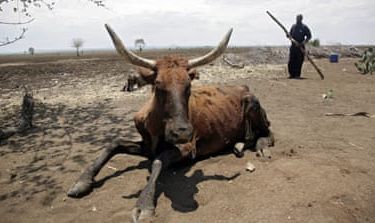A policy agenda for Sustainable Development Goals
Innovative approaches are clearly needed to bridge the funding gaps to achieve SDGs.

In September 2015, nations adopted the 2030 Agenda for Sustainable Development and the associated Sustainable Development Goals (SDGs), signalling firm global intent to integrate environmental development with economic and social development.
December saw the adoption of the historic Paris Agreement, which provides a high-level climate policy framework for environmentally sustainable growth (PDF). But achieving environmentally sustainable, socially and economically inclusive development in an impactful and lasting way will require innovative action on all fronts.
Keep reading
list of 4 itemsThirty years waiting for a house: South Africa’s ‘backyard’ dwellers
Photos: Malnutrition threatens future Afghan generations
From prisoner to president in 20 days, Senegal’s Diomaye Faye takes office
The need for serious investment
Financing this promising agenda will require serious investment – at least $1.5trn extra annually over the Millennium Development Goals (PDF). At the moment, public finance is inadequate for the task.
For instance, large infrastructure in developing areas of Latin America, Asia and Africa – covering transport, energy, water, sanitation and telecommunication – requires $689bn to $1.28trn in incremental annual investment to meet some goals (PDF).
On energy alone, Africa will require cumulative investments of up to $490bn by 2040 for new electricity generation capacity, and 31 percent more for an aggressive focus on renewables to achieve the goal for affordable, reliable and sustainable energy for all.
To progress in the goal on climate change, the United Nations Environment Programme (UNEP) Global Adaptation Gap Report concludes that the world will need to invest up to $500bn annually by 2050 even if humanity is to succeed in holding global temperature rise to 2°C (PDF).
Innovative approaches – including bringing in private funding – are clearly needed to bridge the funding gaps. But there are other ways to secure the cash injection we need.
Environment and sustainable growth
Global processes buttress the critical perspective that achieving sustainable development will require diversified financing in addition to traditional international public finance.
What is urgently needed now are strategies to sustainably harness the world's environmental resources, including appropriate policies and practices to reverse ecosystems degradation, and to combat environmental crimes as well as prioritised allocation of current earnings from environmental resources to catalytic environment-based sectors.
The amount of money and services nature provides to economies is staggering. For example, between $235bn and $577bn worth of annual global food production relies on direct contributions by pollinators – a critical ecosystem service.
The global cocoa bean crop, valued at $5.7bn annually, depends on biodiversity resources, including pollinators. Protecting pollinators therefore directly contributes to SDGs.
In Asia, meanwhile, the economic value of capture fisheries in the Mekong River basin alone is estimated to be between $1.4bn and $3.9bn annually (PDF). More than 120 million people in the Coral Triangle depend directly on local marine and coastal resources for their income, livelihoods, and food security.
Finally, in Africa, environmental resources account for 77 percent of total exports and 42 percent of government revenues, while more than 70 percent of the sub-Saharan Africa population depends on forests and woodlands for livelihood. This means environmental resources directly contribute to creating income opportunities at economy-wide and household level
However, substantial shares of these environmental resources are being lost. For example, the cost of environmental degradation is $9bn annually in the Middle East and North Africa (PDF).
In South Asia, the annual economic loss of land degradation owing to salinisation is estimated at $1.5bn. And in sub-Saharan Africa, the economic loss associated with land degradation is estimated at $68bn per year.
According to UNEP’s Environmental Crime Crisis report, the monetary value of all transnational organised environmental crimes is between $70bn and $213bn annually. This is income that is lost to nations and instead pocketed by criminal groups.
A policy perspective
Given all of the above, it is clear that environmental assets can contribute towards the implementation of the Agenda 2030 and the SDGs in financial terms.
To achieve adequate capacity in implementing the 2030 agenda for sustainable development, countries and regions should put in place mechanisms to ensure the efficient management of natural capital, including reversing environmental loss, resource plunder and illicit financial flows.
OPINION: Climate change and the right to food
A policy measure that could be achieved through national actions is – once environmental loss is reversed – prioritising the allocation of a percentage of environmental-based earnings to sectors that will be highly catalytic in implementing the 2030 Agenda.
Examples include programmes that enhance agro-productivity, and clean energy – two highly potent sectors that are derivatives of natural capital.
This could, especially in the developing world, enhance food security and catalyse the development of rural industry, thus creating jobs and income opportunities. This will combat poverty, enhance food security and expand access to affordable clean energy, which are essential objectives listed in SDGs.
OPINION: The persistence of poverty in the Arab world
This is particularly worthwhile for regions such as Africa, where enhancing productivity of the agro-sector could potentially catalyse achievement of all the SDGs.
There are many other examples of specific ways natural capital can contribute to achieving the SDGs across the board in Africa.
By reversing and recouping environmental losses, averaging more than $200bn annually, this can be injected into high initial cost areas such as healthcare and education, or infrastructure and industrial development.

In addition, these funds can be leveraged as seed capital to explore additional large-scale sources from international public sources, such as enhanced overseas development assistance loans or private sources.
A portion of the average revenues that countries earn directly from the environment through export of timber, fisheries, minerals, agro-produce and tourism could be re-invested to boost productivity of highly potent and inclusive sectors.
For example, investing in ecosystem-based adaptation driven agriculture, and its linkage to sustainable commercial value chains, can enhance not only food security with up to 128 percent yield increases, but enhance farmer incomes – and create jobs with an estimated 17 million jobs in Africa alone – while catalysing an agro-sector worth $1 trillion by 2030.
There is no doubt that sustainably managing the environment offers a cost-effective mechanism for implementing the SDGs.
What is urgently needed now are strategies to sustainably harness the world’s environmental resources, including appropriate policies and practices to reverse ecosystems degradation, and to combat environmental crimes as well as prioritised allocation of current earnings from environmental resources to catalytic environment-based sectors.
This is, of course, a big task, but one that is worth tackling. If we pull it off, then we will be well on the road to creating a better and more just future for all.
Ibrahim Thiaw is UN assistant secretary-general and UNEP’s deputy executive director.
The views expressed in this article are the author’s own and do not necessarily reflect Al Jazeera’s editorial policy.
